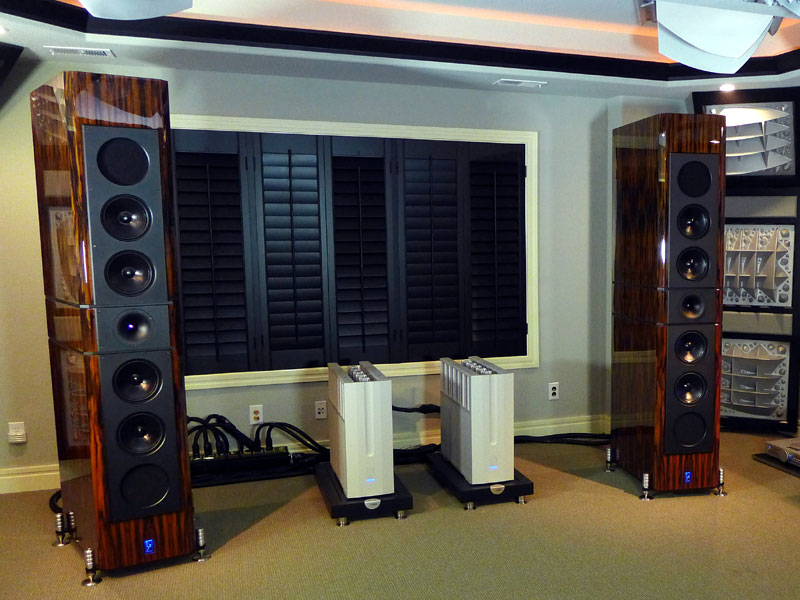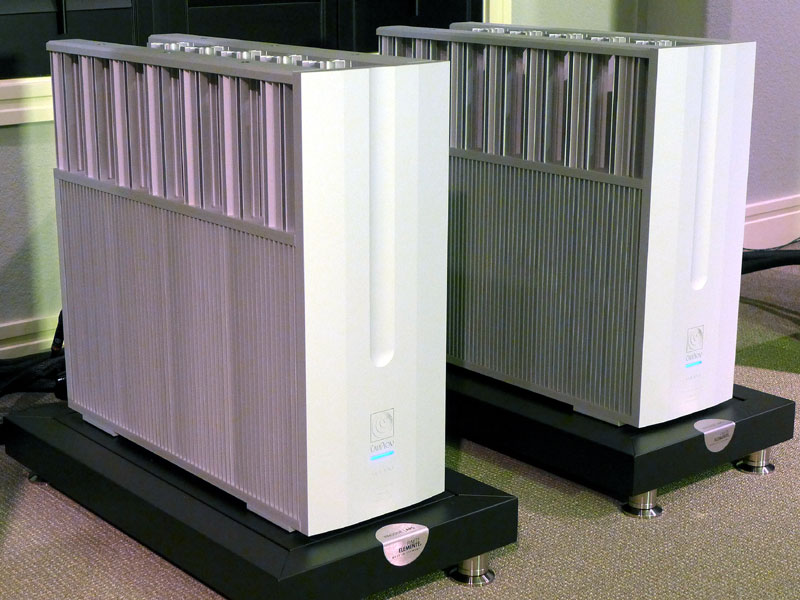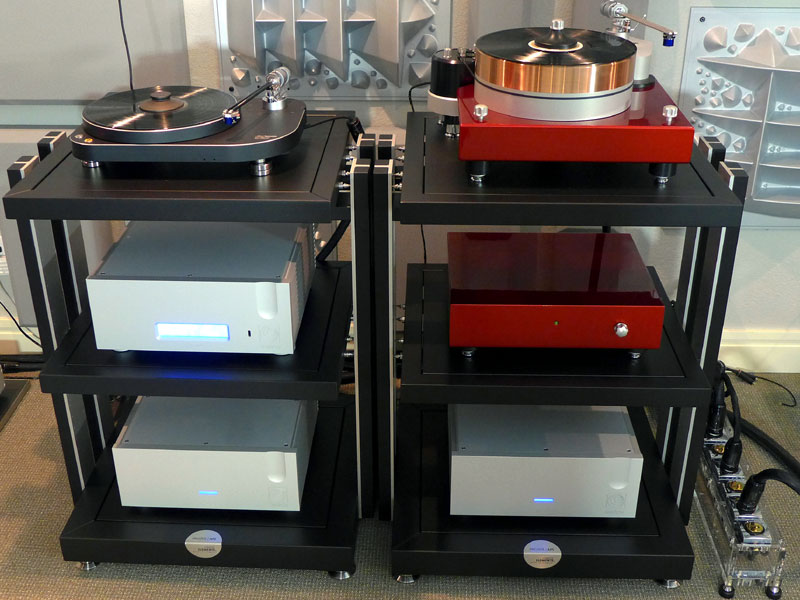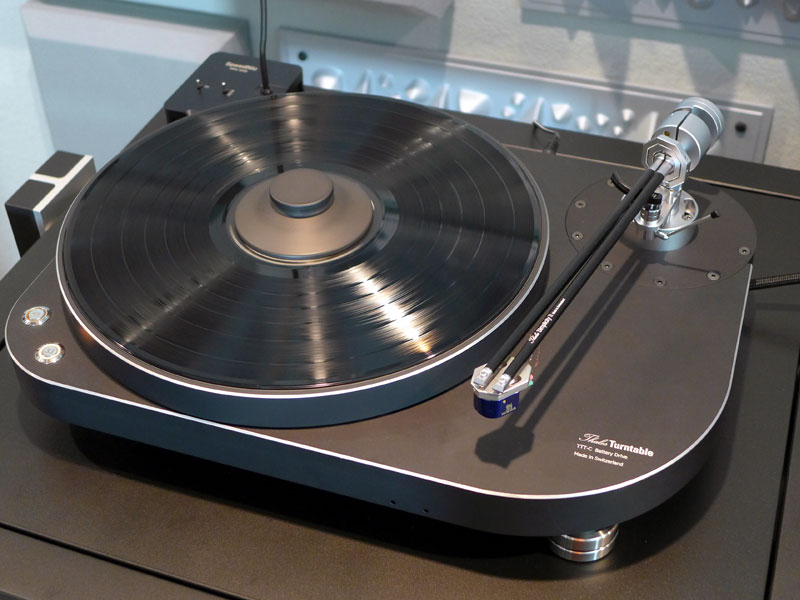Three Times and a New Charm: Aaudio Imports' Reference System
s the title of this article suggests, I've visited Brian Ackerman of Aaudio Imports three times, the latest just a few weeks ago. I can attest to the seriousness with which Brian does his job; in his house, located in Parker, Colorado, which is also where his business is headquartered, there is a place for everything and everything is darned well in its place, including the components that have made up his reference systems -- ambitious and expensive collections, even more so now than years ago. Before I talk about the latest system and its sound, I need to discuss an important constant across all of Brian's systems: his room, which is no afterthought. Its size -- 18 1/2' W x 24' L x 9' H -- is ample though not excessive. What may be excessive, depending on the location of your room and your spouse's acceptance of acoustic treatments, are the many Golden Acoustics panels mounted throughout. These treatments are based on a patented shape the maker calls a Tricon, a "modified cone shape [that] has its foundation in the mathematical science of compound convex forms." The panels, which look like Mad Max's armor, are made of polymerized gypsum and weigh five pounds per square foot, so they can't be mounted with tacks or Velcro. They undoubtedly have great effect on the sound produced in Brian's room, which immediately seems ideal for audio -- neither lively nor dead, about as neutral as any room I've been in, and that includes my own. The equipment is where things get particularly interesting -- both because of cost and performance. In the past Brian has used speakers from Acapella, a brand he once imported. These were always large and esoteric, given their horns and complex cabinets, but his current speakers go beyond them.
The Lansche No.8.2s are absolutely enormous -- each as tall as a small forward and weighing more than two huge defensive linemen -- but considered two-ways, given that their 1/3" plasma tweeter crosses over to four 8" midrange drivers at 2500Hz, with a pair of 18" rear-mounted, powered subwoofers filling in below 40Hz. The cabinets have a deceiving shape; they flare slightly from front to back, giving the impression of almost being toed in when the speakers are not. The speakers cost $266,000/pair, unless you spring for one of the upper-echelon finishes, which adds $10,000 to that price.
The electronics are equally ultimate and together cost more than the speakers. I've heard a couple of Ypsilon products in my system, including the Aelius mono amplifiers. Brian uses the very best from this Greek manufacturer, including versions with silver-wound transformers that add considerably to the price but, Brian says, add even more to the sound. They include Ypsilon's SET 100 Ultimate mono power amps ($125,000 pair), PST 100 Mk II Silver Edition preamp ($74,000), VPS 100 Silver Edition phono stage ($52,000), MC26-L Silver Edition moving-coil step-up transformer ($18,500), and DAC 100 digital-to-analog converter ($29,000). The only non-Ypsilon product was a B.M.C. BDCD1.1 transport ($5390) used for spinning CDs.
The main sources of the system were a pair of very different turntables. The Hartvig Signature TT ($29,700) looks sexy in candy-apple finish, which was matched on the Reference Grade battery power supply ($6800). Brian also had a new option for this 'table: a thick all-copper platter that adds $9000 to the price. This mass-loaded 'table is so heavy that it bowed the top shelf of the rack it was on, prompting Brian to order a carbon-fiber replacement that hadn't yet arrived. The cartridge was an Ikeda Kai ($8500), a low-output moving-coil that, like everything else, is top of the line.
On the other end of the scale, both in terms of physical stature and price, was the Thales TTT-Compact ($13,200) with a Thales Simplicity II Reference tonearm ($9200 and also used on the Hartvig 'table). Another Ikeda Kai cartridge was used here. You can't appreciate the design and visual elegance this turntable exudes until you see the 'table in action. Its battery power supply can play for 22 hours on a charge, and its tonearm is a pivoted-linear-tracking design, the headshell rotating with 'arm position, keeping the cartridge tangential to the groove. Even the mounting system for the cartridge is well thought out. Among the products in this system, this turntable/tonearm combo was the one I most wanted to review -- for the many fine points of its design as well as the fact that I can actually pick it up and move it. Interconnects, speaker cables and power cords were mostly from Stage III, including two Analord Master Ultimate Resolution phono cables ($5300 each), a pair of Medusa Statement Level speaker cables ($18,500/pair), four Kraken Reference power cords ($8400 each) and three Leviathan Statement power cords ($14,500 each). Brian was waiting on new Stage III interconnects, so he was using Thales Line Cable Precision, at a modest $2200/pair. More than once he praised the transparency of these interconnects. Stem to stern, this system comes in at a little over $808,000, including the Finite Elemente Pagode Reference racks ($8970 each) and stands ($3570 each), Cerabase Classic Reference footers ($1060/pair) and Cerabase Slimline Precision footers ($520/three). While it's easy to fixate on the fact that Brian has built a system around the most expensive products he imports, this overlooks the careful choices he has made in terms of the companies he represents. These are brands chosen with a consistent approach. Their products work together to create a single, unwavering view of the music. There's no balancing of one sonic quality with its antithesis, no stacking of complementary colorations to produce a different outcome. There is an adage among writers of fiction that "the story tells itself." The idea is that the writer is simply the messenger, the conduit through which the events come into existence in words. The same was true here. It took all of one digital cut -- played from CD, the actual disc and not a file -- to understand exactly what this system did. The sound was clean, fast, quiet and, most of all, transparent. It existed outside of euphony and any apparent limitations to resolution. The digital cut Brian played sounded impressive, especially the deep bass, which was literally felt and not heard, but it was immediately after, when we began spinning LPs, numerous titles one after another, that the system really shone. None of the LPs we played had the muscularity of the digital cut, but the sense of hearing into the recordings, immediately understanding their essence, was both overwhelming and enlightening. It was as though were were at the recording session, hearing the effect of the choices the engineers were making with musician placement, microphones and equalization, a sensation only approached by the very best reel-to-reel playback. Brian had just gotten a pile of LPs from a garage sale, most of which were not the kind of music I normally buy but were in exceptional shape. The sheer resolution of the system compelled us to clean and play a few of them, especially after we heard the first one, Neil Diamond's September Morn [Columbia CK 33391], followed by the Chuck Mangione war-horse Feels So Good [A&M SP-5053]. I had heard only the title cut of the Neil Diamond LP, and only on FM radio, while Feels So Good was an album I owned back in the late '70s, when its smooth-jazz-meets-disco title cut was an unlikely hit. "Wow," say my notes. "Revealed without artifice or coloration. Transparent, yes, but authentic, the recording utterly revealed. Pedal to the metal." We cycled through James Taylor, Sinatra, Sonny Rollins, Stevie Ray Vaughan, Shelby Lynne -- original pressings, audiophile remasters, mono, stereo, everything we saw and thought to play. With each, there was the same sense of transparency and authenticity. In terms of regions, the treble, with its blinding speed, was extraordinary, as though static electricity should crackle after each plucked string or cymbal strike. The massless Lansche plasma tweeter is capable of great things but equally great disappointment when the electronics are not up to the task. That the Ypsilon electronics can sustain such extreme treble resolution is noteworthy; that they can do so while still sounding natural is an aberration. Brian Ackerman calls this system "an extension of
the dealer's showroom." It's a way for customers to hear and see these products even
if their local dealers don't stock them, which, if we're honest, many will not, simply
because of the cost. But this system is all business in more than this one way. I'm sure
Brian has spent many late nights spinning LPs, just to discover whatever music is within
their grooves. His system lays it out without laying it bare. A memorable listening
experience and a glimpse of hi-fi heaven. |




